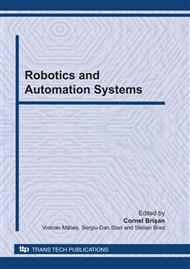[1]
Bruckmann, T.; Mikelsons, L.; Brandt T.; Hiller, M.; Schramm, D. : Wire Robots Part I - Kinematics, Analysis & Design. In Laz, A., editor, Parallel Manipulators, ARS Robotic Books. I-Tech Education and Publishing, Vienna, Austria. ISBN 978-3-902613-20-2. (2008).
DOI: 10.5772/5365
Google Scholar
[2]
Bruckmann, T.; Mikelsons, L.; Brandt T.; Hiller, M.; Schramm, D. : Wire Robots Part II - Dynamics, Control & Application. In Laz, A., editor, Parallel Manipulators, ARS Robotic Books. I-Tech Education and Publishing, Vienna, Austria. ISBN 978-3-902613-20-2. (2008).
DOI: 10.5772/5366
Google Scholar
[3]
Bruckmann, T.; Mikelsons, L.; Hiller, M.; Schramm, D. : A New Force Calculation Algorithm for Tendon-Based Parallel Manipulators. In Advanced Intelligent Mechatronics, 2007IEEE/ASME international conference. 2007. pp.1-6. (2007).
DOI: 10.1109/aim.2007.4412432
Google Scholar
[4]
Bruckmann, T.; Pott, A.; Hiller, M. : Calculating force distributions for redundantly actuated tendon-based Stewart platforms. In Advances in Robot Kinematics, pages 403-412, Ljubljana, Slovenia, 2006. Springer-Verlag. (2006).
DOI: 10.1007/978-1-4020-4941-5_44
Google Scholar
[5]
Spong, W.; Hutchinson, S.; Vidyasagar, M. : {Robot Modeling and Control. John Wiley & Sons, Inc. ISBN 978-0-0471-64990-8. (2006).
Google Scholar
[6]
Fang, S. : Design, Modeling and Motion Contrl of Tendon-Based Parallel Manipulators. PH.D. dissertation, Gerhard-Mercator-University, Duisburg, Germany. Fortschritt-Berichte VDI, Reihe 8, Nr. 1076, Düsseldorf. (2005).
Google Scholar
[7]
Verhoeven, R.; Hiller, M. : Tension Distribution in Tendon-Based Stewart Platforms. Proceedings of the ARK '02, 8th. International Symposium on Advances in Robot Kinematics. (2002).
DOI: 10.1007/978-94-017-0657-5_13
Google Scholar
[8]
Verhoeven, R.; Hiller, M.; Tadokoro, S.: Workspace, stiffness, singularities and classification of tendon-driven Stewart platforms. In Jadran Lenarcic and Manfied L. Husty (editors), Advances in Robot Kinematics: Analysis And Control, pages 105- 1 14, Strobl/Salzburg, Austria, June 1998, Kluwer Academic Publishers. (1998).
DOI: 10.1007/978-94-015-9064-8_11
Google Scholar


